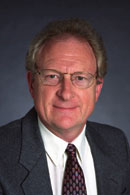
Fields of Research (FoR)
Mathematical SciencesBiography
Colin was born in Great Gonerby, a little village just outside the town of Grantham in Lincolnshire, England. His father was a dairy farmer and he grew up interested in the countryside and farming. At age 11, Colin started at the King's School in Grantham following in the footsteps of Sir Isaac Newton, who was born (rather earlier) in the village of Woolsthorpe, also just outside Grantham.
Colin developed a great interest in natural history...view more
Colin was born in Great Gonerby, a little village just outside the town of Grantham in Lincolnshire, England. His father was a dairy farmer and he grew up interested in the countryside and farming. At age 11, Colin started at the King's School in Grantham following in the footsteps of Sir Isaac Newton, who was born (rather earlier) in the village of Woolsthorpe, also just outside Grantham.
Colin developed a great interest in natural history and especially ornithology, an interest that remains strong today, and probably should have had a career in biology. However, little biology, especially at the higher levels, was done at the King's School presumably because it was a boys school! On the other hand the grammar school for girls had more biology and less physics. (That school too has had its notable pupils: Margaret Thatcher and more importantly Johanna, who became Colin's wife.)
So Colin's final years at school were devoted to studying Pure Mathematics, Applied Mathematics and Physics, plus German and other odd bits and pieces. Then it was off to the University of London where he entered Queen Mary College's physics program with an emphasis on theoretical physics and mathematics.
Colin then decided to come to Australia! People at Queen Mary College said he was insane - nobody goes to Australia. However, they relented when Colin told them he was coming to work with Professor John M. Blatt. (His 1952 book with Victor Weisskopf, "Theoretical Nuclear Physics" was the bible in that subject and was even reprinted in 1979, and he was also famous for work on superconductivity.) So it was that Johanna and Colin sailed for Australia late in 1964.
Colin gained his PhD from the University of New South Wales and after a brief time at Duke University, he became a lecturer in the Department of Applied Mathematics at UNSW. Some of his first lectures were in numerical analysis, classical dynamics and fortran programming.
In 1971, Colin took up a Queen Elizabeth Fellowship in the just established Department of Applied Mathematics in the Research School of Physical Sciences at ANU. He stayed on there in the Institute of Advanced Studies as a Fellow and progressed to Senior Fellow in 1978. His research interests developed in optics and vision, especially in waveguide theory and fibre optics, with various offshoots into coherence theory and things like numerical analysis and nonlinear classical dynamics. The whole family enjoyed a stay in Germany while Colin was on leave to work on insect vision at the Max Planck Institute in Tubingen.
In 1986, Colin became Professor and Head of the Department of Mathematics (later the School of Mathematics and Statistics) in University College, that part of the University of New South Wales at the Australian Defence Force Academy in Canberra. So once again, he was working for UNSW and interacting with undergraduate students which he greatly enjoyed after spending a long time in a purely research environment. In 2000, Colin became Presiding Member of the University College Academic Board. He has also done a stint as Deputy Rector.
Some of the many areas of research Colin has worked in include
- Theoretical nuclear physics - especially the effects, derivation and mathematical forms of three-body potentials
- Waveguide theory and the design of optical fibres
- Methods for characterising optical fibres and their measurement
- Geometric optics and the concept of leaky rays
- Coherence theory and representations of optical fields
- Coherence effects in fibre optics, diffraction theory, image formation, inverse source problems and measurement methods in vision science
- Chaos in ray theory and optical circuits
- Potential shapes and properties, regular and irregular motion in classical dynamics
- Images and super-resolution
- Insect photoreceptors and their waveguide properties
- Tapering dielectric waveguides and their applications in fibre optics and to insect lens systems
- Inverse problems and methods for measuring preforms and biological lens properties
- Human vision - photoreceptor properties and their influence on the visual process and on measurement techniques
- Nonlinear optics - waveguide mode mixing, frequency mixing and generation, the spectral theory on pulses, momentum in nonlinear optics
Colin gave up being Head of School after 12 years so he could concentrate more on some things Professors like to do - research, teach and write. Colin has written three books - Math for the Frightened (2011), Magnificent Principia (2013) and Great Calculations (2015).